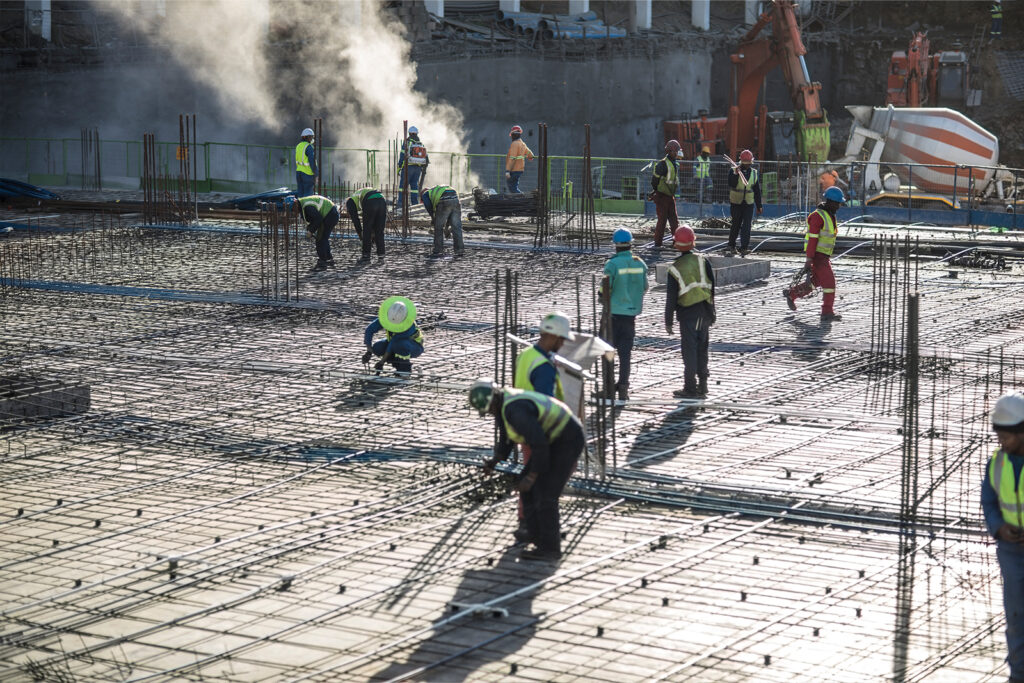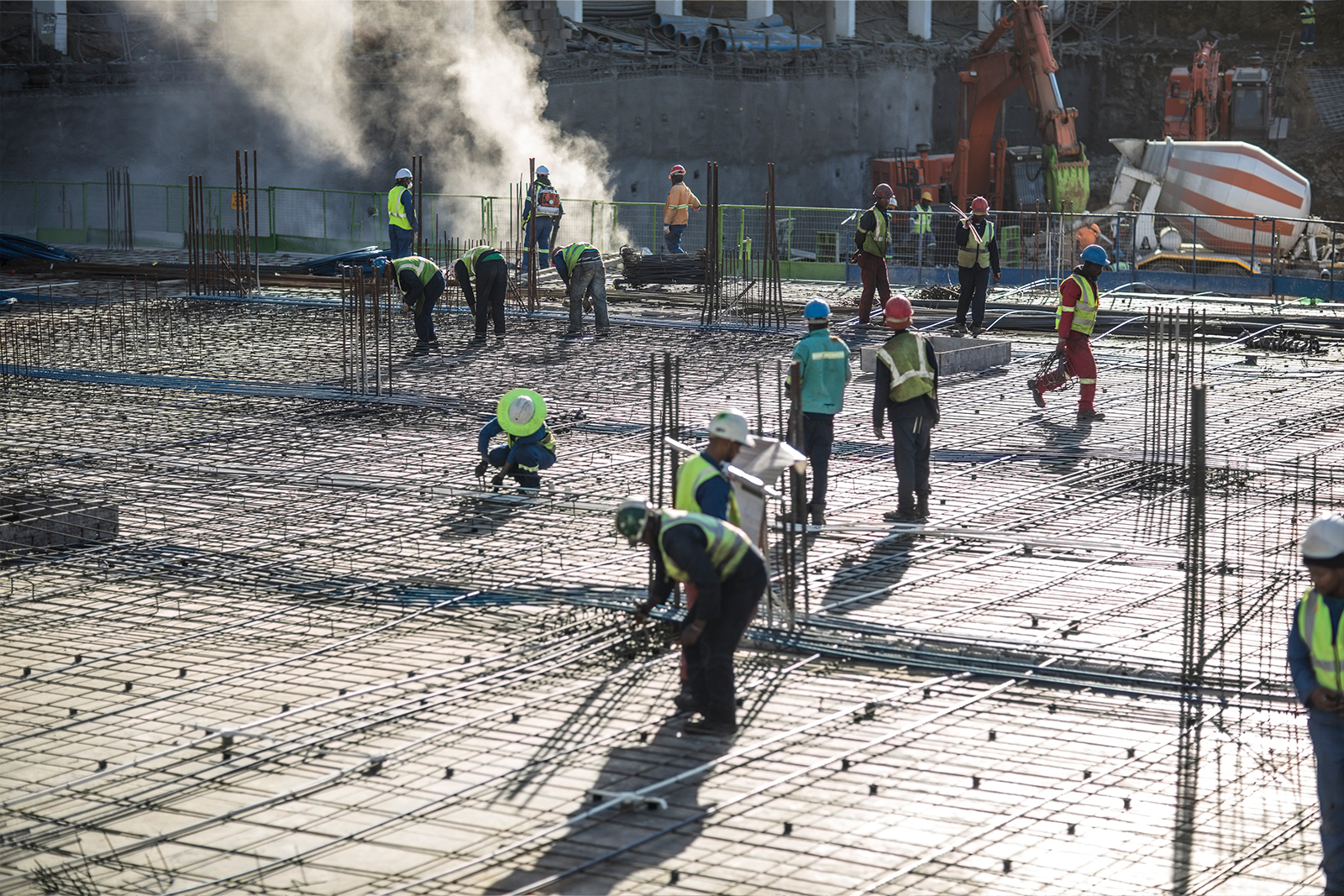Mastering the Art of Concrete Slab Foundation Construction

Introduction
Concrete slab foundations are a common choice for modern construction projects because they are durable and cost-effective. These foundations provide a strong base for buildings, ensuring stability and energy efficiency.
Key benefits of choosing a concrete slab foundation include:
Durability: Resistant to pests and moisture.
Energy Efficiency: Offers thermal mass, reducing heating and cooling costs.
This guide provides a detailed step-by-step process for building a solid concrete slab foundation. By following these instructions, you will have the knowledge to confidently take on this project.
If you’re interested in exploring alternative construction methods that can further enhance your building’s potential, consider tilt wall construction. This innovative approach offers numerous benefits, making it a top choice for many developers.
It’s also important to understand the significance of site stabilization in construction planning. Site stabilization plays a crucial role in ensuring safe and long-lasting structures, and knowing its importance is key to your project’s success.
1. Understanding Concrete Slab Foundations
Concrete slab foundations are a popular choice in the construction industry due to their versatility and robustness. A concrete slab foundation consists of a thick, horizontal layer of concrete poured directly onto a prepared surface. This type of foundation provides a stable base for various building structures, effectively distributing the weight of the structure across the ground.
Key advantages of concrete slab foundations:
Durability: Concrete slabs offer exceptional durability, able to withstand heavy loads and resist damage from environmental factors.
Stability: A well-constructed slab foundation provides solid support, minimizing the risk of settling or shifting over time.
Cost-effectiveness: Compared to other foundation types, such as crawl spaces or basements, concrete slabs can be more cost-effective due to lower material and labor costs.
The combination of these factors makes concrete slab foundations an efficient choice for both residential and commercial projects. They not only ensure long-term structural integrity but also provide significant savings on initial construction costs.
2. Key Steps in Constructing a Concrete Slab Foundation
2.1. Preparing the Site for Construction
Thorough site preparation is crucial for building a stable and durable foundation. A well-prepared site prevents issues like uneven settling, which could compromise the structural integrity of your concrete slab.
Steps to Prepare the Site:
Clearing Vegetation and Debris: Remove any existing vegetation, including grass, shrubs, and trees.
Clear away debris like rocks, old construction materials, and trash to ensure a clean working area.
Leveling the Ground: Use grading equipment to level the ground surface. This ensures uniformity and helps prevent water pooling under the slab.
Grading should also take into account proper drainage to avoid future water damage.
Marking and Layout: Use stakes and builder’s lines to outline the exact dimensions of your foundation.
Double-check measurements to make sure they align with your building plans.
For additional insights on construction grading, you can refer to our comprehensive guide on Laying The Foundation: Construction Grading. This resource will provide you with an in-depth understanding of how construction grading plays a vital role in building strong foundations, ensuring stability and enhancing aesthetics.
Incorporating these steps ensures that your site is perfectly prepared for subsequent stages, such as excavation and reinforcement placement.
2.2. Understanding Foundation Depth and Excavation Techniques
Now let’s explore the importance of foundation depth and excavation techniques that are suitable for different soil conditions and comply with local building codes.
But before we proceed, it would be beneficial to learn more about our Warehouse Design Guide, which provides valuable information on the complexities of construction and various warehouse types for optimized storage solutions. This knowledge can be useful if you’re planning to include a warehouse in your project, as it involves careful design and construction considerations.
2.3. The Expertise of MBC Construction in Commercial Concrete Foundations
MBC Construction specializes in Commercial Concrete Foundations, which are essential for supporting large buildings and infrastructure projects. Their expertise in form place finishes can elevate the quality of your concrete work, enhancing both its appearance and durability. These insights can be invaluable as you navigate through the various phases of your construction journey.
2.2. Understanding Foundation Depth and Excavation
Accurate layout is crucial in determining the size and shape of your foundation. Here’s how you can do it:
Use stakes and builder’s lines to mark precise locations. Start by placing stakes at each corner of the foundation, then connect them using builder’s lines to create an outline.
Make sure you follow these key steps for proper excavation:
Marking and Measuring: Use a measuring tape and level to ensure all dimensions are accurate.
Excavation: Use suitable tools like shovels or backhoes to dig evenly across the entire site.
Depth Considerations: Take into account any extra depth needed for insulation or drainage systems.
Understanding soil conditions and local building codes is essential before starting any excavation work. These factors often determine the minimum depth required, usually known as the frost line, to prevent frost heave.
Frost heave occurs when water in the soil freezes and expands, causing upward pressure on the foundation. Digging below the frost line helps protect against this issue.
By following these guidelines, you’ll create a strong foundation that’s ready for reinforcement placement and concrete pouring.
If you require specialized assistance with complex equipment foundation construction, you can rely on MBC Management. They offer services that prioritize stability, strength, and safety for such projects.
Additionally, if you’re looking for earthwork services like mass grading, MBC Management’s Mass Grading Services can be explored. This technique not only improves efficiency but also reduces construction costs.
2.3. Ensuring Structural Integrity through Reinforcement Methods
Reinforcements such as steel mesh and rebar are crucial in enhancing the strength and crack resistance of a concrete slab. These materials provide the necessary tensile strength to counteract the natural weakness of concrete under tension.
Steel Reinforcing Mesh:
Commonly used to improve load distribution.
Placed within the formwork before concrete pouring.
Ensure it is positioned correctly to avoid contact with the ground, which can cause rusting.
Rebar (Reinforcing Bar):
Positioned in a grid pattern for optimal support.
Tied together at intersections using wire ties for stability.
Must be secured above the frost line to prevent structural issues due to ground movement.
Steps for Proper Reinforcement Placement:
Site Preparation and Excavation: Ensure the site is clear of debris and vegetation, and excavate to proper depth considering local building codes.
Formwork Setup: Construct formwork to hold concrete in place during setting, ensuring dimensions align with project specifications.
Placement of Steel Mesh: Lay steel mesh within formwork, lifting it slightly off the ground using spacers.
Positioning Rebar: Insert rebar into formwork following a specified grid pattern, tying intersections securely with wire ties.
Inspection: Double-check placement for compliance with engineering plans.
To further enhance your knowledge on concrete slab construction, it would be beneficial to explore concrete finishing techniques that boost durability and style in commercial spaces, as well as achieving optimal concrete curing conditions for stronger and more durable commercial structures. These resources provide expert insights on best practices and methods, ensuring that your project meets professional standards.
2.4. Pouring and Finishing the Concrete
Pouring the concrete mixture onto the prepared site involves several critical steps to ensure a strong and durable foundation. Begin by ensuring site preparation is thorough, with excavation completed to the appropriate depth, often reaching below the frost line to prevent future cracking.
Concrete Pouring Process
Mix concrete to the specified consistency.
Transport the mixture to the site.
Pour the concrete evenly over the prepared area.
Use screed tools to level and smooth the surface, removing excess material.
Finishing techniques vary based on aesthetic preferences and functional requirements:
Troweling
Provides a smooth finish.
Ideal for indoor applications where a polished appearance is desired.
Broom Finish
Achieved by dragging a broom across the surface.
Creates a textured finish that enhances slip resistance.
Both methods offer unique benefits, enhancing both the look and usability of your slab. For examples of expertly finished projects, you can explore MBC Management’s impressive portfolio. Their portfolio showcases their expertise in delivering successful solutions through a wide range of projects.
Additionally, if you are looking for advanced construction needs, it’s worth considering Crane-Ready Building Construction, an innovative approach offered by MBC Management that lifts construction projects to new heights with modern techniques.
3. Curing and Post-Construction Care for Concrete Slab Foundations
The curing process is vital in ensuring that your concrete slab foundation achieves maximum strength and durability. Proper curing minimizes the risk of cracks and structural weaknesses.
The Curing Process
Curing involves maintaining adequate moisture, temperature, and time to allow the concrete to achieve its desired properties. Here are some steps:
Initial Setting: After pouring and finishing, allow the concrete to set initially.
Moisture Maintenance: Keep the surface moist by using water sprays or wet coverings like burlap.
Curing Compound: Applying a curing compound can help seal in moisture and protect the surface.
Post-Construction Maintenance
Maintaining your concrete slab foundation post-construction ensures its longevity and performance. Key maintenance practices include:
Regular Inspections: Check for cracks, spalling, or any signs of movement.
Sealing: Periodically apply a sealant to protect against moisture infiltration.
Cleaning: Keep the surface clean from debris and stains.
Understanding these processes helps ensure a robust and durable foundation for your construction projects.
4. The Suitability of DIY Construction for Slab Foundations
Engaging in a DIY project for constructing a concrete slab foundation can be both rewarding and challenging. The decision to take on such a project should be weighed carefully, considering both the benefits and potential risks.
4.1. Pros and Cons of Taking on a DIY Slab Foundation Project
Benefits of DIY Construction:
Cost Savings: By undertaking the project yourself, you can significantly reduce labor costs, which often account for a substantial portion of the overall budget.
Hands-On Satisfaction: Completing a major construction task provides immense personal satisfaction and a sense of accomplishment.
Learning Experience: A DIY project offers an excellent opportunity to learn new skills and gain practical knowledge that can be applied to future projects.
Customization: You have complete control over the design and execution, allowing for personalized touches that cater specifically to your needs and preferences.
Risks Involved in DIY Construction:
Technical Skill Requirements: Constructing a concrete slab foundation requires specific technical skills and knowledge. Mistakes in site preparation, reinforcement placement, or concrete pouring can lead to structural issues down the line.
Time-Intensive: DIY projects often take longer than anticipated, especially if you are learning as you go. This can result in delays and extended timelines.
Liability: Any errors or accidents on-site become your responsibility. This includes potential legal ramifications if the structure fails to meet local building codes or safety standards.
Quality Assurance: Without professional oversight, ensuring the quality and durability of the foundation can be challenging. Missteps in construction could lead to costly repairs or even complete reconstruction.
When considering whether to undertake a DIY slab foundation project, think about your own experience level, availability of resources, and readiness to handle unforeseen challenges. For those who feel confident in their abilities and have access to necessary tools and materials, taking on such a project might be an appealing option.
To better understand the expertise required for industrial-grade concrete work, such as slab foundation construction, it is worth visiting What Makes a Concrete Contractor Industrial Grade?. This resource provides valuable insights into the distinguishing factors of an industrial-grade concrete contractor, including their expertise, equipment, and commitment to quality.
Balancing these pros and cons can help you make an informed decision about whether a DIY approach is suitable for your specific situation. If you’re uncertain about any aspect of the construction process or if the project scope exceeds your comfort level, it may be wise to explore professional assistance.
4.2. When to Consider Hiring Professionals
There are certain situations where it’s best to hire professionals for concrete slab foundation construction. This ensures that the work is done correctly and meets all necessary building regulations. Here are some scenarios where professional help is highly recommended:
1. Complex Soil Conditions
If the soil on your site has poor load-bearing capacity or is highly expansive, professional contractors can conduct soil testing and recommend appropriate solutions to prevent future foundation issues.
2. Large-Scale Projects
For extensive construction projects, expertise in project management and access to specialized equipment are crucial. Professionals bring efficiency and precision that DIY projects might lack.
3. Compliance with Building Codes
Navigating local building codes and regulations can be daunting. Professionals have the experience to ensure all aspects of the construction meet legal standards, reducing the risk of costly violations.
4. Advanced Reinforcement Techniques
Ensuring structural integrity through proper reinforcement placement is critical. Experienced contractors are skilled in using steel mesh, rebar, and other materials correctly, enhancing the foundation’s durability and longevity.
Hiring professionals for these situations mitigates risks associated with DIY projects, providing peace of mind that your concrete slab foundation is built to last.
Conclusion
Applying the knowledge from this guide can empower you to undertake your own concrete slab foundation projects with confidence. Whether you choose to do it yourself or hire professionals, understanding the important factors of site preparation, excavation, reinforcement, and finishing will guarantee a strong and stable foundation.
A well-built concrete slab foundation offers many advantages including:
Durability
Energy efficiency
Cost savings
Use this guide as a complete resource to guide you through your construction process, ensuring the success of your project.




